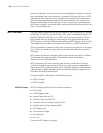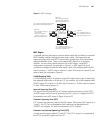
Configuring STP 245
spanning tree calculation is launched again by new events, for example, the
link from Switch B to C is down or the port receives a better configuration
BPDU.
GigabitEthernet1/1/1 receives the updated configuration BPDU, {0, 5, 1,
e1/1/4}, from Switch B. Since this configuration BPDU is better then the old
one, the old BPDU will be updated to {0, 5, 1, e1/1/4}.
Meanwhile, GigabitEthernet1/1/5 receives the configuration BPDU from Switch
A but its configuration BPDU is not updated and remains {0, 0, 0, e1/1/2}.
By comparison, the configuration BPDU of GigabitEthernet1/1/1 is elected as
the optimum one. GigabitEthernet1/1/1 is elected as the root port, whose
BPDU does not change, while GigabitEthernet1/1/5 is blocked and retains its
BPDU, but it does not receive the data forwarded from Switch A until spanning
tree calculation is triggered again by changes, for example, the link from
Switch B to C is down.
Thus the spanning tree is stabilized. The tree with the root Switch A is
illustrated in
Figure 3.
Figure 3 The Final Stabilized Spanning Tree
The root ID and the designated switch ID, in actual calculation, should include
both switch priority and switch MAC address. The designated port ID should
include port priority and port MAC address. In the updating process of a
configuration BPDU, other configuration BPDUs besides the first four items make
modifications according to certain rules. The basic calculation process is described
below.
Configuring the BPDU
Forwarding Mechanism
Upon the initiation of the network, all the switches regard themselves as the roots.
The designated ports send the configuration BPDUs of local ports at a regular
interval of HelloTime. If it is the root port that receives the configuration BPDU, the
switch will enable a timer to time the configuration BPDU, as well as increase
MessageAge carried in the configuration BPDU by certain rules. If a path goes
wrong, the root port on this path will not receive configuration BPDUs anymore,
and the old configuration BPDUs will be discarded due to timeout. Recalculation
of the spanning tree will be initiated to generate a new path to replace the failed
one, and thus restore the network connectivity.
The new configuration BPDU as now recalculated will not be propagated
throughout the network right away, so the old root ports and designated ports,
that have not detected the topology change, will continue to forward the data
Switch A
with priority 0
Switch B
with priority 1
Switch C
with priority 2
4
5
E1/1/7
E1/1/1
E1/1/4
E1/1/1


















